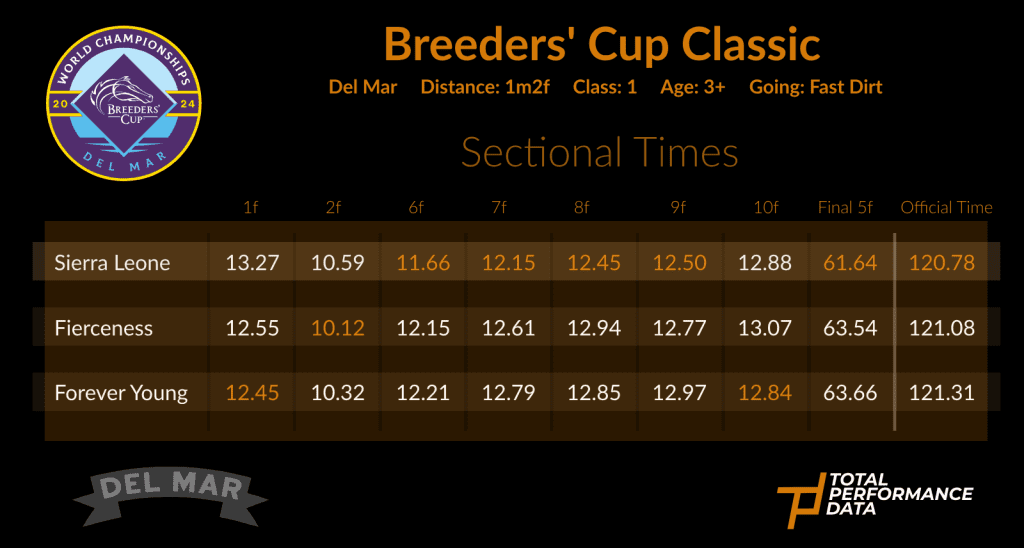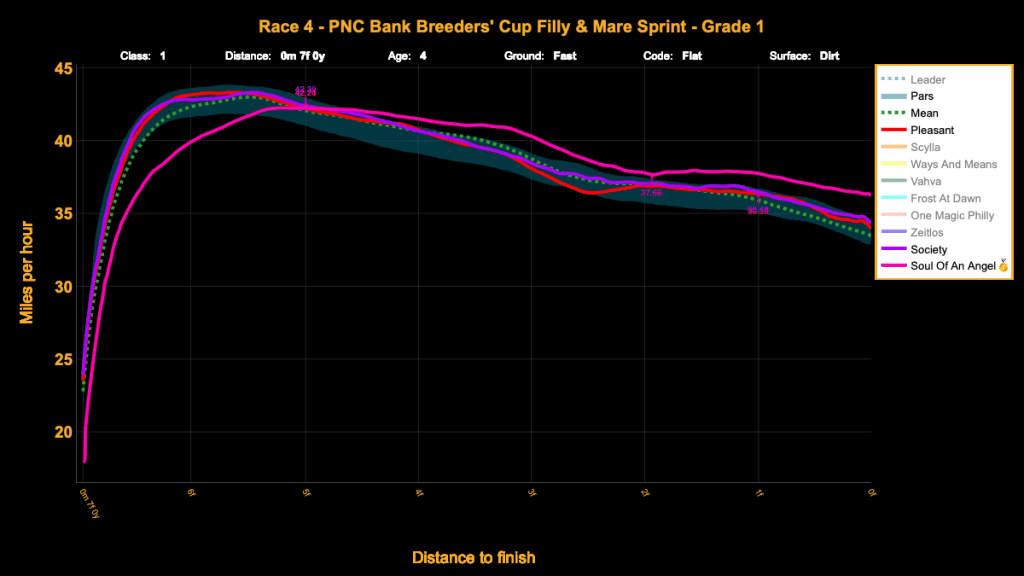The Breeders’ Cup has passed for another year. Whilst many reviews of the weekend’s racing at Del Mar might begin with the Breeders’ Cup Classic (I will come to that) and the performances of Sierra Leone and City of Troy, I wanted to start mine with a look at the Juveniles on Friday night. After everything that happened on Saturday, the weekend may have a slightly disappointing feel for Coolmore and Ryan Moore, but on Friday night I believe that data shows that he produced a couple of the best rides of his career in the Juvenile Turf races and they need to be celebrated. Secondly and perhaps more significantly, I believe that the performance of Immersive was one of the best in the entire meeting and I will be shocked if she doesn’t feature in the review of the 2025 Breeders’ Cup too. From there I will move on to the Classic, where the data shows that Sierra Leone would have won regardless and why there might be a few small crumbs of comfort for the connections of City of Troy.
Breeders’ Cup Juvenile Fillies
Immersive is exceptional. This was a 4th win in 4 starts for Brad Cox’s filly and with a finishing speed of 89.32%, this was her strongest test to date. She passed with flying colours to win by a comfortable 4-lengths. At 25.76 ft, she had the longest peak stride length in the field and this enabled Manuel Franco to keep her in contention with the strong early pace before moving her around the leaders on the final turn, covering more ground than the runner-up in the process. Her final furlong split of 13.39s is the fastest in the field, but more importantly she is the only horse to quicken significantly in the final furlong compared to the penultimate and her final speed of 32.93 mph, taken 2s after she had crossed the line, is over 1 mph faster than any of the other runners, including the running on Quickick (3rd). On this evidence, she has to be the leading 2-year-old prospect in the US with a view to 2025.
Breeders’ Cup Juvenile Fillies Turf
One of Ryan Moore’s greatest rides. It takes such courage to rein a horse back when you’re drawn in stall 1 at the Breeders’ Cup. Having tried and failed to get her to the front, Moore was able to settle Lake Victoria in mid-division, having narrowly avoided a collision as they turned out of the straight in the process. This proved to be a stroke of genius. There were 5 horses in this field who ran their second furlong in sub-11 seconds and of those, only Kilwin (5th) played any part in the finish. At 11.35s, Lake Victoria was ranked 10th of 14 for this section of the race. In fact, Lake Victoria didn’t run the fastest furlong at any point in this race. Instead, she made steady progress to close on the leaders and at 2.55 strides per second, she had the highest maximum stride frequency in the field, which allowed her to quicken through the gap on the home turn when it came and once in front she was always holding the 2nd placed May Day Ready. Where many riders may have panicked, Ryan Moore remained calm and once he got his mount into position turning for home, this outstanding filly did the rest.
Breeders’ Cup Juvenile Turf


To win any Breeders’ Cup race from stall 13 is an incredible achievement and it was yet another Ryan Moore masterclass as he steered Henri Matisse to victory with a sustained run down the outside of the field. This was a ride that focussed on efficiency, Henri Matisse was ranked 4th for average stride frequency, 5th for his peak stride frequency and at 41.18 mph, his top speed figure was only 11th of the 12 runners and yet still, he won.
That being said, I do want to spare a thought for the connections of Aomori City, who finished an unlucky 3rd. He took 12.58s to reach the 7-furlong pole compared to the 12.32s taken by Henri Matisse and that is the biggest difference between the pair in the entire race. Having dropped in rear, he has been forced to wait for his chance, but he has closed in final sectionals of 11.89 and 11.29s, 0.14s faster than the winner and his run-out speed of 38.36 mph is the fastest in the field and fully 1.23 mph quicker than the winner, suggesting that there was more left in the tank had he been closer. Having been briefly inconvenienced by New Century jumping to his right from the gate, he lost vital lengths on the winner but on another day, if they broke on level terms, he may well have reversed this form.
Breeders’ Cup Classic


Forget City of Troy (we will come to him later) and focus on Sierra Leone, he was brilliant. Slowly away in 13.27s, 13th of 14 in the field for the run to the 9-furlong pole, he has run the next 5 individual furlongs in sub-12 seconds to get himself into position and his finishing kick is something to behold. Having been fully 1.19s behind Fierceness after the opening 2 furlongs, but from there this is a performance all about sustained momentum and we should note that Sierra Leone has had to race 4-wide around the final turn to get himself alongside. John Velazquez has probably gone too soon onboard Fierceness and we should note that he is slowing down over each of his last 4-furlongs, but Sierra Leone has taken 1.9s out of him over the final 1,000 metres and still had enough energy to run the 2nd fastest final furlong of the race. At 42.12 mph, his top speed is lower than that of Fierceness (43.64) and Forever Young (43.96), but it is his ability to sustain his speed over a longer period that has ultimately won him the race. A peak average stride length of 27.27 ft, fully 2.02 ft longer than Fierceness and the longest in the field, is perhaps the key to this sustained gallop.
The connections of Forever Young may point to the fact that he was running on at the finish and he did run the fastest final furlong split in the field (12.84s), but over the final 2-furlongs he is actually 0.43s slower than Sierra Leone and a 3rd placed finish is ultimately a fair result for the Japanese star.
I’ll add some notes on City of Troy. I think it is fairly obvious by now that he didn’t enjoy the surface and there is nothing in the data to counteract that. A false step to his left at the start has ended any real chance and despite running a 2nd furlong of 10.79s, the fastest of his career, he has never been able to get himself into contention. A top speed of 41.88 mph is slightly faster than the 41.65 mph that he clocked at York, but as I discussed last week, the start was the key to the race. He took 5.8s to reach 30 mph at Del Mar, compared to 4.8s at York, and that was the difference. This performance should not detract from what has been a fantastic 3-year-old season.
Breeders’ Cup Turf
It wasn’t a perfect night for Charlie Appleby as both Cinderella’s Dream and Notable Speech failed to land the prize, but with Rebel’s Romance, the boys in blue hit the target. This race is a perfect example of the need for early speed. Rebel’s Romance took 24.84s to reach the 10-furlong pole, 0.71s quicker than the runner-up Rousham Park and in a race that he ultimately won by 0.04s, that was the key. He took 4.8s to reach 30 mph, faster than any of the next 5 horses to chase him home and although Rousham Park had a higher top speed and both a longer stride and higher stride frequency, that early speed made all the difference.
Breeders’ Cup Filly & Mares Sprint


When a horse wins with a starting price of 33/1, the form is always open to question and whilst Soul of an Angel deserves credit for winning this 7-furlong sprint, I have come to the conclusion that it was circumstance rather than true ability that allowed her to prevail. Having missed the break, she was able to stay away from the fierce early pace and having been as much as 1.45s behind after 2-furlongs, she recovered to win as the pace collapsed, rather than with a turn-of-foot. Her run-out speed of 35.23 mph is the best in the field, but her top speed of 42.37 mph is the slowest of the 8 runner field and as the TPD pace chart shows, she was far from the fastest horse in this field. I would be very surprised to see her confirm this form if meeting her rivals on similar terms in the future.